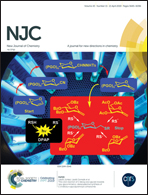A concerted addition mechanism in [Hmim]Br-triggered thiol–ene reactions: a typical “ionic liquid effect” revealed by DFT and experimental studies†
Abstract
A concerted one-step addition mechanism for anti-Markovnikov hydrothiolation in [Hmim]Br catalyzed thiol–ene reactions is revealed by a combined DFT and experimental study for the first time. This special mechanism represents a typical “ionic liquid effect”, which is driven by the directional hydrogen bond and π+–π interactions that conjoin the substrates and [Hmim]Br into a prereactive complex. The transition state is stabilized and characterized by a planar 6-membered ring containing HBr and four substrate atoms at the reaction site. The concerted addition mechanism and the special structural feature of the TS render the reaction regiospecific, i.e. only the anti-Markovnikov product is produced. When the styrene is replaced by aliphatic alkenes, the substrates are loosely bound with the ionic liquid. As a result, the prereactive complex is destabilized and the reactivity drops significantly.
![Graphical abstract: A concerted addition mechanism in [Hmim]Br-triggered thiol–ene reactions: a typical “ionic liquid effect” revealed by DFT and experimental studies](/en/Image/Get?imageInfo.ImageType=GA&imageInfo.ImageIdentifier.ManuscriptID=C8NJ05674A&imageInfo.ImageIdentifier.Year=2019)


 Please wait while we load your content...
Please wait while we load your content...